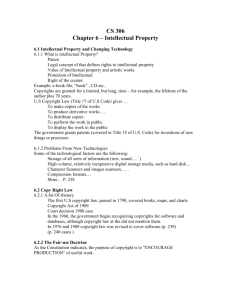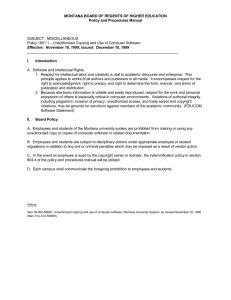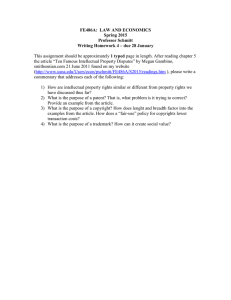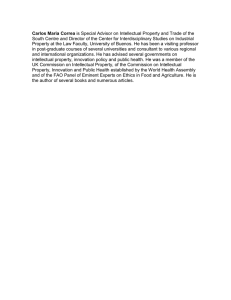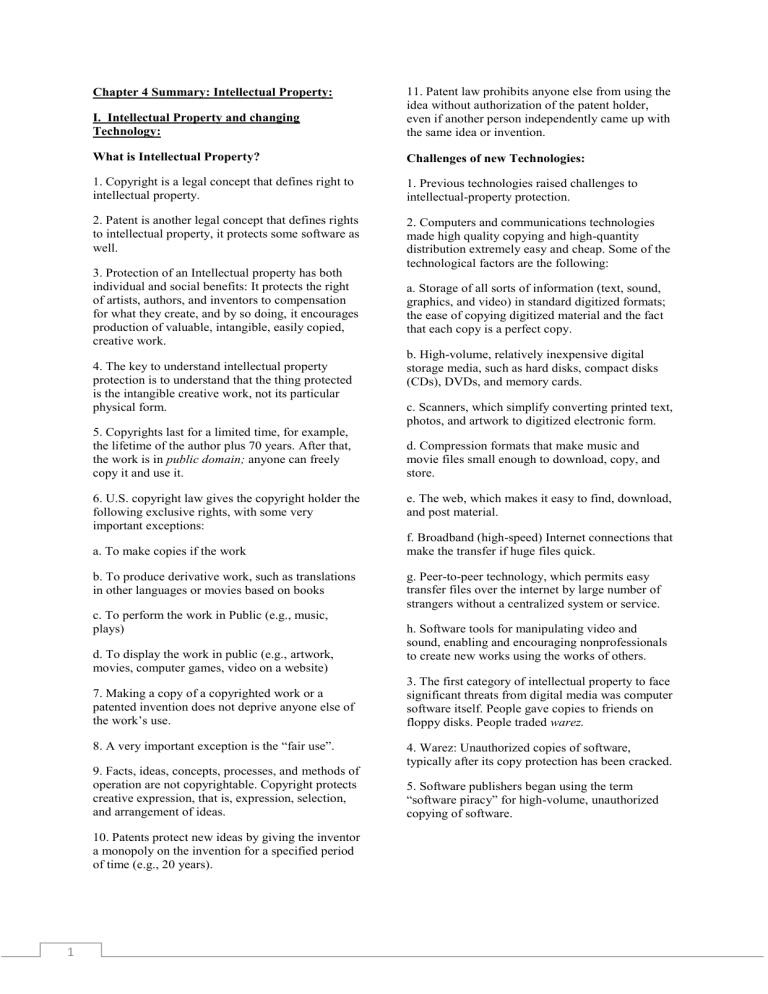
I. Intellectual Property and changing Technology: 11. Patent law prohibits anyone else from using the idea without authorization of the patent holder, even if another person independently came up with the same idea or invention. What is Intellectual Property? Challenges of new Technologies: 1. Copyright is a legal concept that defines right to intellectual property. 1. Previous technologies raised challenges to intellectual-property protection. 2. Patent is another legal concept that defines rights to intellectual property, it protects some software as well. 2. Computers and communications technologies made high quality copying and high-quantity distribution extremely easy and cheap. Some of the technological factors are the following: Chapter 4 Summary: Intellectual Property: 3. Protection of an Intellectual property has both individual and social benefits: It protects the right of artists, authors, and inventors to compensation for what they create, and by so doing, it encourages production of valuable, intangible, easily copied, creative work. 4. The key to understand intellectual property protection is to understand that the thing protected is the intangible creative work, not its particular physical form. 5. Copyrights last for a limited time, for example, the lifetime of the author plus 70 years. After that, the work is in public domain; anyone can freely copy it and use it. 6. U.S. copyright law gives the copyright holder the following exclusive rights, with some very important exceptions: a. To make copies if the work b. To produce derivative work, such as translations in other languages or movies based on books c. To perform the work in Public (e.g., music, plays) d. To display the work in public (e.g., artwork, movies, computer games, video on a website) 7. Making a copy of a copyrighted work or a patented invention does not deprive anyone else of the work’s use. 8. A very important exception is the “fair use”. 9. Facts, ideas, concepts, processes, and methods of operation are not copyrightable. Copyright protects creative expression, that is, expression, selection, and arrangement of ideas. 10. Patents protect new ideas by giving the inventor a monopoly on the invention for a specified period of time (e.g., 20 years). 1 a. Storage of all sorts of information (text, sound, graphics, and video) in standard digitized formats; the ease of copying digitized material and the fact that each copy is a perfect copy. b. High-volume, relatively inexpensive digital storage media, such as hard disks, compact disks (CDs), DVDs, and memory cards. c. Scanners, which simplify converting printed text, photos, and artwork to digitized electronic form. d. Compression formats that make music and movie files small enough to download, copy, and store. e. The web, which makes it easy to find, download, and post material. f. Broadband (high-speed) Internet connections that make the transfer if huge files quick. g. Peer-to-peer technology, which permits easy transfer files over the internet by large number of strangers without a centralized system or service. h. Software tools for manipulating video and sound, enabling and encouraging nonprofessionals to create new works using the works of others. 3. The first category of intellectual property to face significant threats from digital media was computer software itself. People gave copies to friends on floppy disks. People traded warez. 4. Warez: Unauthorized copies of software, typically after its copy protection has been cracked. 5. Software publishers began using the term “software piracy” for high-volume, unauthorized copying of software. 6. Copying music and movies became easy, fast, cheap, and ubiquitous. The scope of the term “piracy” expanded to include high-volume, unauthorized copying of any form of intellectual property, whether by large numbers of individuals sharing files without charge or by underground groups selling unauthorized copies for high profits. 7. Video cameras and tools and video-sharing sites enabled members to the public to provide entertainment for each other and to post and share professional videos owned by others. 8. Estimates show that people copy, trade, and sell billions of dollars of its intellectual property without authorization. 9. Enforcement has been fierce, but much legal content is free to cheap due to improved technology and the many services that provide free content sponsored by advertising. 3. No single factor alone determines whether a particular use id fair use, but the last one generally gets more weight than the others. Significant Cases: 1. Under what circumstances we as consumers can legally copy music, movies, software, etc… 2. Developers of new software, recording devices, game players, and other products often must copy some or all of another company’s software as part of the process of developing the new product. The new product might compete with the other company’s product. Is such copying a fair use? The court said that private, noncommercial use should be presumed fair unless there is a likelihood of economic harm of the copyright holder. II. Copyright Law and Significant cases: Reverse Engineering: game machines A bit of History: 1. The definition of unauthorized copy in the Copyright Act 1909 specified that it had to be in a form that can be seen and read visually. 2. In 1976 and 1980 Congress revised copyright law to cover software. The Fair Use Doctrine: 1. The Fair-Use doctrine allows uses of copyrighted material that contribute to the creation of new work and uses that are not likely to deprive authors or publishers income for their work. 2. Four factors to consider in determining whether a particular use is “fair use”: a. The purpose and nature of use, including whether it is for commercial purposes or nonprofit educational purposes. (Commercial use is less likely to be fair use.) b. The nature of copyright work. (Use of creative work, such as novel, is less likely than use of factual work to be fair use.) 1. To make their games run properly, Accolade needed to figure out how part of Sega’s game machine software worked. Accolade copied Sega’s program and decompiled it. This is called Reverse Engineering. 2. Sega sued; Accolade won. Accolade was making new games, the court viewed Accolade’s activities as fitting the purpose of fair use, that is, to encourage production of new creative work. 3. Making copies of a program for reverse engineering was not copyright infringement. It was a fair “research” use. 4. Reverse Engineering is an essential process for creating new products that must interact with other companies’ hardware and software. III. Copying and Sharing: c. The amount and significance and portion used. d. The effect of the use on the potential market for or value of the copyrighted work. (Uses that reduce sales of the original work are less likely to be considered fair.) 2 To people who enjoy getting movies and music online, the problem is to get them cheaply and conveniently. To writers, singers, artists and actors- and to the people who work in production, marketing, management- the problem is to ensure that they are paid for their time and effort they put in to create the intangible intellectual property products we enjoy. To the Entertainment industry, publishers and software companies, the problem is to protect their investment and expected, or hoped for, revenues. To the millions who post amateur works of using works of others, the problem is to continue to create without unreasonably burdensome requirements and threats of lawsuits. To scholars and various advocates, the problem is how to protect intellectual property, but also protect fair use, reasonable public access, and the opportunity to use new technologies to the fullest to provide new services and create work. Defensive and Aggressive Responses from the Content Industries: A variety of techniques for protecting software were developed early, with varying success: 1. Software companies encoded an expiration date in free sample versions of software. The software destroyed itself after that date. 2. Some business software includes hardware dangle, a device that the purchaser has to plug into a port on the computer so that the software can run, thus ensuring the software only runs on one machine at a time. 3. Consumer software publishers use “copy protection” on disks to ensure that you cannot copy a disk, or if you can, the copy won’t run. 4. Some software requires activation or registration with a special serial number. 5. Some of these systems were cracked by programmers who found ways to thwart the protection mechanisms. 6. In most cases, violations of copyright law were so clear that the business or organization agreed to fines if hundreds of thousands of dollars rather than to go to trial. 7. The Business Software Alliance (BSA), a software industry organization, still “busts” a few hundred companies each year for using illegally copied software. BSA offers rewards of up to $1 million for people who report serious offenders. 8. On the early internet, software publisher organizations searched the Internet for 3 keywords and phrases such as “warez” and “cheap software” to find targets for their enforcement actions. 9. As data speeds increased and video sharing sites inspired more unauthorized copying, the entertainment industry and startup companies developed sophisticated tools to search billions of web pages for copies of specified texts, images, sound, or video. Banning, suing, and taxing: 1. The technology for consumer CD recording devices for music was available since 1988, but lawsuits filed by record companies delayed its introduction. 2. The record industry sued to block digital audio tape (DAT) and DAT recorders and lobbied for law banning DAT machines without built-in copy protection. 3. The movie and record industries delayed introduction of DVD players by threatening to sue companies that make them if consumers could copy movies on the devices. 4. The entertainment industry pushed hard for laws and industry agreements to require that makers of PCs and digital recorders and players build copyprotection mechanisms into their products. It pressured device makers to design their systems so that files in unprotected formats do not play well – or at all. 5. Laws requiring or prohibiting specific features violate the freedom of manufacturers to develop and sell products they consider appropriate. Digital rights Management: 1. Digital rights Management (DRM) technologies are a collection of techniques that control uses of intellectual property in digital formats. Copy protection on disks was an early example. 2. DRM has become more sophisticated. It includes hardware and software schemes using encryption and other tools. 3. DRM provides flexibility, allowing the producer of a file to specify what a user may do with it. With the ability to build in limits on the life or uses of digitized works, record companies began to sell songs and offer subscription services where consumers could listen to a specified number of songs each month for a fixed fee. More uses of Advertising: 4. There are many criticisms of DRM. DRM prevents fair uses as well as infringing uses. 2. Movie companies adopted that too. 5. DRM has a serious disadvantage for the content industries: It does not really protect them. Virtually all copy-protection schemes are quickly cracked. The DMCA versus Fair use, Freedom of Speech, and Innovation “Every time a 42 year old figures out how to lock something, a 14 year old is going to figure out a new program.” Jim Griffin 1. Programmers and researchers frequently find ways to crack or thwart DRM and other copy-protection schemes that control uses of movies, e-books, music, etc… 2. The DMCA prohibits making, distributing, or using tools (devices, software, or services) to circumvent technological copyright protection systems used by copyright holders. Some music companies adopted a clever tactic to discourage unauthorized file sharing: 1. The put a large number of damaged music files called “decoys” on file sharing sites. 3. Eventually, some companies developed a new marketing model using similar techniques. Coca Cola, for example, includes advertising, not scratches, with music files distributed to peer-to-peer sites. Fan fiction: Let it be 1. Fan fiction includes stories written by amateurs using characters or worlds from popular fiction such as Harry Potter and Star Trek. 2. The characters and environments in fan fiction are creative intellectual property covered by copyright. Fan stories are not copies of copyrighted work, but they are derivative works. 3. With derivative works, publishers worry not only about loss of potential revenue but also about damage to their image. Ethical arguments about Copying: Video Sharing: 1. When videos do not use anyone else’s material, there is no problem of copyright infringement. Videos that use a small piece of a large work might be within the fair-use guidelines. 2. Large copyright holders are unhappy that they continually search sites for material that infringe their copyrights and send the notices. Negotiated Payments: Some Entertainment companies and Web content-sharing sites negotiate contracts for the website company to pay a share of its ad revenue to the entertainment companies. 4 1. There is intrinsic “fuzziness about the ethics of copying. The border between what is and what is not ethical is often unclear. 2. The value of intellectual property is not just the direct use and enjoyment one gets from a copy. Its value is also as a product offered to consumers to earn money. That is an aspect of the property that one can steal from copyright holder. 3. When people widely copy intellectual property without permission, they diminish the value of the work as an asset to the owner. That is why much copying is wrong. 4. Many businesses give free samples and low-priced introductory offers to encourage sales, but that is a business decision. 5. People who copy for personal use or distribute work of others with charge usually do not profit financially. Personal use is, reasonably, more likely to be fair use (both ethically and legally) than commercial use. 6. Vandals do not profit financially from their action, but vandalism is unethical (and a crime) because it destroys –or reduces the value of-someone’s property. 7. Many kinds of abusive or threatening speech are unrelated to financial gain but are unethical. 8. The guidelines might need expansion and clarification to cover new media, but they give us a good framework that corresponds to sensible ethical criteria. IV. Search Engines and Online Libraries: 1. Copying is essential to many of the operations and services of search engines. 2. Besides their own copying, search engines provide links to sites that might contain copyright infringement material. 3. The search engine practice of displaying copies of excerpts from web pages seems easily to fit under the fair-use guidelines. V. Free Speech Issues: VI. Free Software: What is Free Software? 1. Free software is an idea, an ethic, advocated and supported by a large looseknit group if computer programmers who allow and encourage people to copy, use, and modify their software. 2. The free in free software means freedom, not necessarily lack of cost, though often there is no charge. 3. Free software enthusiast advocate allowing unrestricted copying of programs and making the source code available to everyone. 4. Software distributed or made public in source code is open source, and the opensource movement is closely related to the free software movement. 5. Stallman compares a piece of software to a recipe, we can all decide to add a little garlic or take out some salt without paying royalties to the person who developed the recipe. 6. Under copy left, the developer copyrights the programs and releases it under an agreement that allows people to use, modify, and distribute it, or any program developed from it, but only if they apply the same agreement to the new work. Domain names: 1. Some businesses and organizations use trademark infringement claims to sue or threaten suits against people who register domain names that express criticism of the company or organization. 2. In many cases, the company or product name is not used in a negative or critical way. 3. Some companies use a market mechanism rather than lawsuits: They buy hundreds of domain names that include names of their products, not to use the names themselves, but to prevent other from using them. 5 7. No one may develop a new program from the copylefted program and add restrictions that limit its use and free distribution. 8. Critics of free software point out some of its weakness. Much free software is not easy for ordinary consumers to use. There is no technical support number to call for help. 9. Many businesses want to deal with a specific vendor from whom they can request enhancements and assistance. They are uncomfortable with the loose structure of the free-software movement. VII. Issues for Software developers: Patents for Software: 1. Recall that patents protect inventions of devices and processes. They give the inventor a monopoly on the invention for a specific period of time. 2. Anyone else who wants to use the idea or process or build a similar device must get the authorization of the patent holder. 3. There is much controversy about whether patent is an appropriate mechanism for software. Exporting Products: A patent protects intellectual property only within the country that grants the patent. Thus, to protect against foreign companies making, selling, or using its patented inventions without authorization, a company must apply for patents in many countries. Copyright and similar software: 1. A program that used well-known and widely used techniques and routines could infringe another program’s copyrights. 2. Identify the purpose of the program, remove from consideration the parts that are in the public domain; are common practice, or are the only efficient way of accomplishing some part; copyright does not protect them. 3. Compare the remaining parts of the two programs to see how similar they are. 4. For this section 4.7.3, I advise you to read the book!! Best of luck 6

